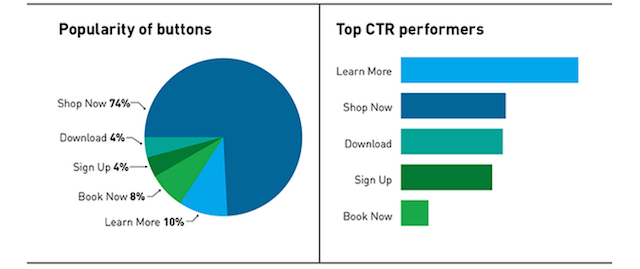A call to action (CTA) is essential for guiding your audience towards the next step, whether it’s signing up for a newsletter, making a purchase, or learning more about your brand. Crafting a great CTA requires precision, creativity, and a touch of urgency to encourage users to take action.
So, in this article, we’ll cover what makes a CTA effective, where to use them, and actionable tips to make them powerful. Keep reading to find out more!
What Is a Call to Action (CTA)?
A call to action, or CTA, is a prompt designed to encourage your audience to complete a specific action, such as clicking on a link or making a purchase. CTAs are often seen on/in webpages, emails, social media posts, and ads, guiding users to actions like “Sign up”, “Buy now”, “Learn more”, “Click here”, or “Get started”. Basically, CTAs are imperative statements that, without any beating around the bush, tell your audience how to behave. Although this might seem overly forthright, this overtness actually works in their favour. CTAs are both clear and honest; they’re not trying to trick your audience.
Understanding your target audience is critical to designing an effective CTA, although they do tend to be simple and to the point, no matter who the audience is. By knowing what resonates with them, you can craft CTAs that are clear and compelling. It’s also important to know where CTAs belong—and where they don’t. Generally, they are more at home in shorter texts that clearly have a marketing purpose. The more complex and informational the text, the more out of place they can seem. Although they can still work in such texts, they should be integrated less aggressively.
![]() A call to action (CTA) is a prompt used to encourage specific user actions. CTAs should resonate with the target audience in order to be effective.
A call to action (CTA) is a prompt used to encourage specific user actions. CTAs should resonate with the target audience in order to be effective.
Where Can You Use a CTA?

CTAs are used in numerous marketing materials, some of which we mentioned earlier. They’re usually found online, although they can also be found on physical ads, such as billboards or printed adverts. However, below we’ll focus on online marketing, as that is where the overwhelming number of CTAs are found. Here’s where you’re most likely to see them:
- Websites: CTAs guide website visitors toward desired actions, like downloading resources or signing up for newsletters.
- Emails: CTAs in emails prompt readers to click through for further content, product recommendations, or deals.
- Social media: Engaging CTAs in posts and ads can lead followers to additional content or offers.
- Blog posts: CTAs can encourage readers to explore more content or engage with products related to the post.
- Meta descriptions: Many meta descriptions will end with a CTA, such as “Click here” or “Find out more”. These encourage the reader to follow the link to discover more about a topic.
From product pages to blog posts, CTAs can be found embedded wherever interaction is encouraged. Most of them appear on websites, but some are also found in communications (as with emails) or on browser pages (as with meta descriptions).
![]() CTAs are valuable in multiple contexts, from websites and emails to social media and blogs, making them essential for engaging audiences across marketing channels.
CTAs are valuable in multiple contexts, from websites and emails to social media and blogs, making them essential for engaging audiences across marketing channels.
Why Are Calls to Action Important?
CTAs are generally considered a vital part of online marketing. In fact, they’re so ubiquitous that it’s very difficult to say how much their absence might impact a business. With that in mind, let’s take a look at exactly why they’re important for your business, and therefore, why you should use them.
They Help and Direct Your Audience
CTAs serve as signposts directing users toward helpful or relevant actions. For example, if you’re offering valuable insights in a blog post, a CTA can guide readers to related content or products, enhancing their experience. Otherwise, they might work to direct people towards a product page, sign-up page, or something else.
Not only this, but they also signal to search engines what certain pages and links do. Buying keywords indicate a shop page, whereas informational keywords let a search engine know that a page is; for instance, a blog article. CTAs are not the main means used to help search engines identify what purpose a page serves, but they are another tool in the SEO arsenal.
They Grow Your Audience and Sales
Effective CTAs encourage conversions, whether that’s a product sale, social media follow, or newsletter sign-up. By creating well-placed and clear CTAs, you’ll grow your audience and ultimately boost revenue. In this way, CTAs help to drive traffic of all kinds in the direction of your choosing.
Think of a short post outlining your new e-commerce site. On its own, it might be informative, but people are likely to lose interest unless it is followed up with a CTA and link, such as “Sign up here” or “Get your first month free”. This makes a post much more powerful and means that the content you create leads directly to actions from your desired customer base. This, in turn, increases engagement, visibility, and sales.

Source: sproutsocial.com
They Provide Structure
CTAs bring a logical flow to content, guiding readers from one action to the next. This structure is especially useful on landing pages and in emails, where each step has a defined goal, such as encouraging a purchase or reading a certain article. Much like with the previous point, this influences users to follow the path you’ve designed for them, whether that’s to learn more information or press “buy”.
Take a blog article. This article likely relates to other topics and/or products on a given site. Integrating CTAs into a blog can help readers navigate to these pages to discover more information or related products. This doesn’t just help you and your customers, but it also boosts your SEO by showing search engines that people stay on your site to find more information, rather than navigating elsewhere. It also proves that you have a coherently curated space with relevant information.
![]() CTAs guide users, boost conversions, and structure content to meet business goals effectively.
CTAs guide users, boost conversions, and structure content to meet business goals effectively.
How to Use CTAs in Your Content
So, we’ve taken a look at why CTAs are important; now it’s time to look at how to use them effectively. Spam your audience, and CTAs will be more of a hindrance than help. Moreover, if your CTAs don’t have a destination, users and search engines alike will be put off. In other words, it is important to use CTAs properly if you want them to do their job, and so creating an impactful CTA strategy takes some thought. Here are some tips to craft CTAs that stand out.
Always Try to Add a CTA
Even if it’s a simple “Read more” or “Discover our blog”, CTAs can be added to almost any piece of content to keep the audience engaged and encourage further exploration on your site. This should be taken with a caveat, though: only try to add a CTA where appropriate. This means they should be placed where a further action is organic or helpful, not littered all over the place. A blog post that is constantly trying to direct readers elsewhere, especially when it isn’t useful, will be a great turn-off.
While CTAs can direct people towards useful information, they can also break the flow of text, distract, and even annoy, particularly if they are trying to get people to make purchases. Be particularly sparing when trying to get people to part with their money, as you don’t want to come across as pushy.
Use More Than One
If it’s appropriate, don’t be afraid to include multiple CTAs. For example, a blog post could have a “Sign up for updates” CTA at the beginning and a “Download our guide” at the end. As mentioned, when CTAs point towards useful, related information and products, they are mostly welcomed.
When placing CTAs, consider putting them in less information-dense parts of the text as you’ll want to keep the flow easy to ensure reader clarity. The only exception is if you have another article that goes deeper into a subject, in which case you can direct towards that content at the necessary point.
On the other hand, if you’re adding a CTA to a short text, it can be better to keep it to one, such as “Sign up here” or “Click here to find out more”. A short text that directs to more than one destination might have the unintended consequence of making it difficult for readers to make up their mind on where to go, ultimately resulting in them taking no further action. If the goal of a small text is to move readers on to somewhere else, choose where you want them to go and make that your sole focus for greater impact.
Make Them Powerful

To write a powerful call to action, consider using strong action verbs that inspire immediate engagement, such as “Get”, “Download”, “Join”, or “Try”. Phrasing that implies benefit or urgency, like “Claim your free trial today”, can be especially compelling. Power also allows for brevity, which ensures maximum clarity, use of space, and impact.
As CTAs are overt in their purpose, there’s no need to try to make them subtle—this would just negate their power. People know what CTAs are and what purpose they serve; they will be looking out for clear statements that indicate they can move elsewhere or fulfil an action.
Avoid Confusion
CTAs should be straightforward, so avoid excessive text or complex language. The audience should instantly understand what action they’re expected to take. A CTA is not just a call to action, but, as stated, a clear sign post that tells your audience what to do and/or where to go.
“Click here to find out more” is much more straightforward than something like, “The following link will provide further information”. As noted, people know what CTAs are, and are therefore primed to expect certain words and phrases. Don’t try to differentiate here—just give people what they expect.
Keep Your CTAs Simple
With the above in mind, simple CTAs are easy to understand and quick to process. “Join now”, “Subscribe”, or “Learn more” are all examples of clear, concise CTAs that require little thought and don’t take up unnecessary space. In many cases, CTAs also double as hyperlinks—so they serve two purposes: letting people know where a link leads, and attaching this link to relevant text. For either of these purposes, brevity and clarity trump complexity.
Make Sure They Stand Out
The visibility of your CTAs is crucial. Use contrasting colours, large font, or buttons to ensure each CTA stands out from the rest of your content. Again, this is in part because many CTAs are likely to be links, and it’s common practice for links to be highlighted in some way. Many people will scan texts quickly, so having CTAs and links that stand out means your audience can instantly identify where and what they are, and click on them. If they don’t stand out, your CTAs will likely be passed by.
Consider Device Type
Users interact with content differently depending on the device they’re using. Ensure that CTAs are accessible and look good on both desktop and mobile to maximise reach. The best way to do this is standardise them and ensure that whatever platform you use to host your site or deliver your newsletters is optimised for both desktop and mobile.
Track Your CTAs
Use tools to track CTA performance so you can determine whether or not they are effective. Analysing click-through rates, conversions, and other metrics helps refine your CTAs over time, allowing for maximum effectiveness.
![]() Effective CTAs are clear, visible, trackable, and designed to inspire action through simplicity and strategic placement.
Effective CTAs are clear, visible, trackable, and designed to inspire action through simplicity and strategic placement.
Create Great CTAs and Accomplish Your Goals
CTAs are a powerful and very simple tool in the marketer’s arsenal. Unless you can come up with something very effective and novel, we’d recommend not choosing CTAs as an area in which to experiment with unconventional approaches. They have become commonly accepted as a means of communication between sites, users, and search engines, and almost everyone intuitively knows what to look out for and what different CTAs indicate.
Though simple, using CTAs well still takes a little thought and practise. But you should get there in no time!


